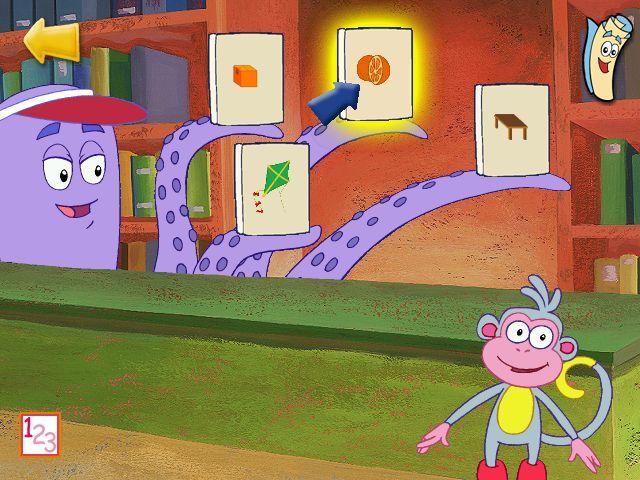Retro Replay Review
Gameplay
From the moment you step into Dora the Explorer: Backpack Adventure, the game greets you with customizable sign-in pages and a charming sticker book interface. You begin by decorating your sticker book with a selection of backgrounds and placeholders, which instantly engages young players in a creative warm-up before any actual gameplay begins. As you earn stickers throughout the adventure, you’re encouraged to revisit and redecorate that book, giving this educational title a tangible reward loop.
(HEY YOU!! We hope you enjoy! We try not to run ads. So basically, this is a very expensive hobby running this site. Please consider joining us for updates, forums, and more. Network w/ us to make some cash or friends while retro gaming, and you can win some free retro games for posting. Okay, carry on 👍)
The core of the gameplay is split between two distinct modes: Backpack Adventure Mode and Map Mode. In Backpack Adventure Mode, you follow a linear path with Dora that guides you through story-driven tasks—collecting books for the library, helping friends, and thwarting Swiper’s mischievous attempts. Map Mode, by contrast, allows you to tackle mini-games in any order you choose, granting freedom and replayability. This dual-mode structure ensures that players can both enjoy a narrative progression and dip into focused skill-building exercises at will.
Each mini-game is cleverly designed to reinforce early-childhood concepts such as color and shape recognition, pattern completion, number recognition, and classification. The point-and-click mechanics are intuitive, relying on simple mousing skills suitable even for novice computer users. Accessible controls, a visible “map” character to orient you, a level icon for difficulty adjustments, and a back arrow for easy navigation all work together to provide an unforced, frustration-free experience.
The reward system is simple yet motivating: every time you help Boots, Isa, Benny, or even stop Swiper, the Fiesta Trio—a musical bug, frog, and snail—dances across the screen to present your hard-earned sticker. This visual celebration cements positive feedback and keeps young players eager for the next challenge. And once enough stickers are earned, the smile on your child’s face as they decorate their sticker book or print out their creation is the game’s greatest affirmation of success.
Graphics
Dora the Explorer: Backpack Adventure features bright, colorful graphics that closely mirror the beloved TV series. The environments are simple yet engaging, with bold outlines and high-contrast colors that grab and hold a child’s attention. Every background—from lush jungle scenes to the friendly neighborhood library—is rendered in a way that feels both cheerful and easy to navigate.
Character animations are smooth and expressive, especially for Dora and her pals. Dora’s signature pink shirt and orange shorts pop against the scenery, while Boots’ energetic hops and Benny’s gentle bounces bring personality to each mini-game. Even Swiper’s sneaky movements are animated with a cartoonish flair that clearly communicates his playful intent without being overly menacing.
The sticker book interface is another visual highlight: glossy sticker icons, detailed backgrounds, and drag-and-drop decorations provide a satisfying tactile quality. Children can admire their progress through this scrapbook-style gallery, which feels less like a menu and more like an art project waiting to be customized and shared.
Story
The narrative framework of Backpack Adventure is simple but effective for its target age group. Dora’s mission to return books to the library sets a clear goal, and along the way, she crosses paths with familiar faces from the show: Boots, Isa, Benny, and the ever-persistent Swiper. Each character interaction introduces a mini-puzzle or task, creating organic learning opportunities tied directly to the story.
Tasks range from gathering tools for Isa to helping Benny bounce his balloon friends back together, each one serving as both a gameplay mechanic and a storytelling beat. Swiper’s cameo appearances—and the required “Swiper, no swiping!” chants—encourage reading and speaking along with the game, fostering engagement and language development.
While the plot is straightforward, it remains vibrant and kid-friendly, with recurring appearances by the Fiesta Trio to celebrate each success. These mini-celebrations reinforce the game’s positive tone and give children a sense of accomplishment after every chapter. The episodic structure means kids can play in short bursts or longer sessions without losing track of the story’s flow.
Overall Experience
Dora the Explorer: Backpack Adventure strikes an excellent balance between education and entertainment. Its point-and-click simplicity, paired with a reward-driven sticker book, creates a nurturing environment for learners developing motor skills and cognitive abilities. Parents can feel confident that their children are practicing real-world skills—color matching, counting, problem solving—while immersed in Dora’s familiar universe.
The choice between a guided adventure and free-form mini-games caters to different moods and attention spans, making this title adaptable to various learning styles. Whether a child prefers the structure of Backpack Adventure Mode or the exploration of Map Mode, the game supports both approaches without compromising on fun or educational value.
Graphically appealing and emotionally uplifting, Backpack Adventure features an array of well-designed tasks and characters that enhance its narrative and pedagogical goals. The user interface is intuitive, the feedback is immediate, and the creative sticker book offers lasting replay value. For families seeking a gentle yet purposeful introduction to computer-based learning, Dora the Explorer: Backpack Adventure is an engaging, wholesome choice that delivers on its promise of fun and foundational skill building.
 Retro Replay Retro Replay gaming reviews, news, emulation, geek stuff and more!
Retro Replay Retro Replay gaming reviews, news, emulation, geek stuff and more!









Reviews
There are no reviews yet.